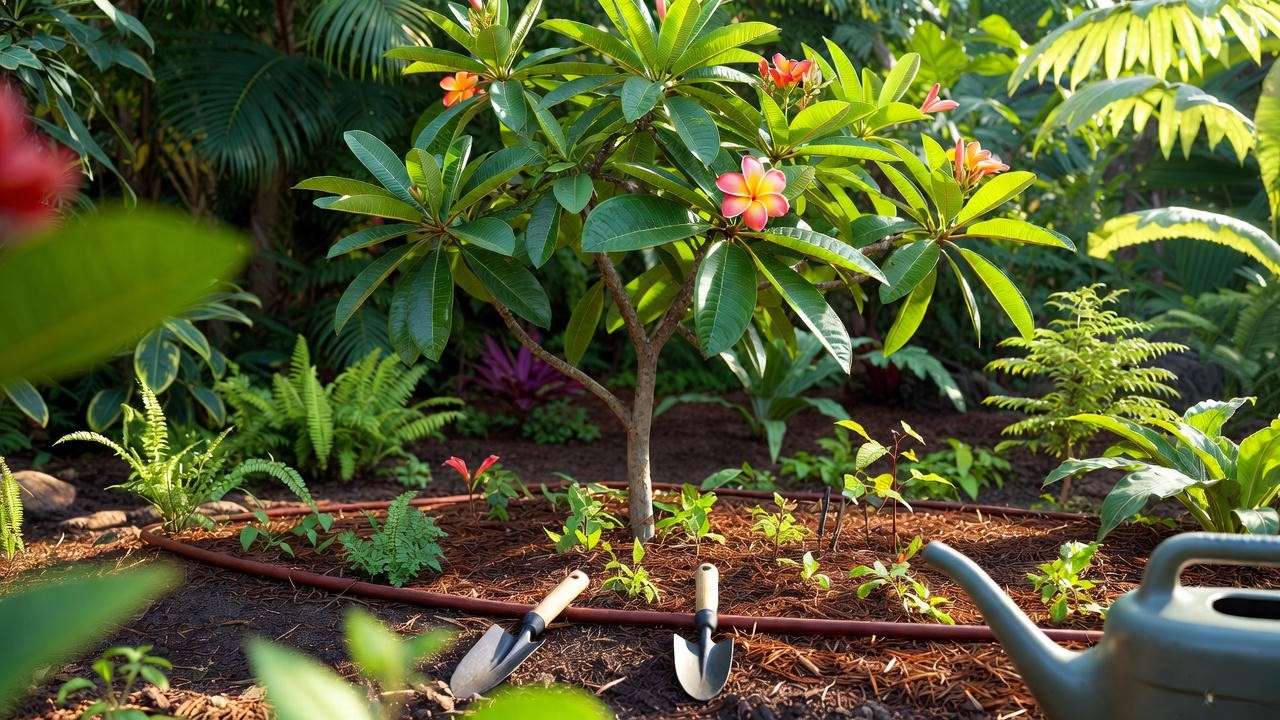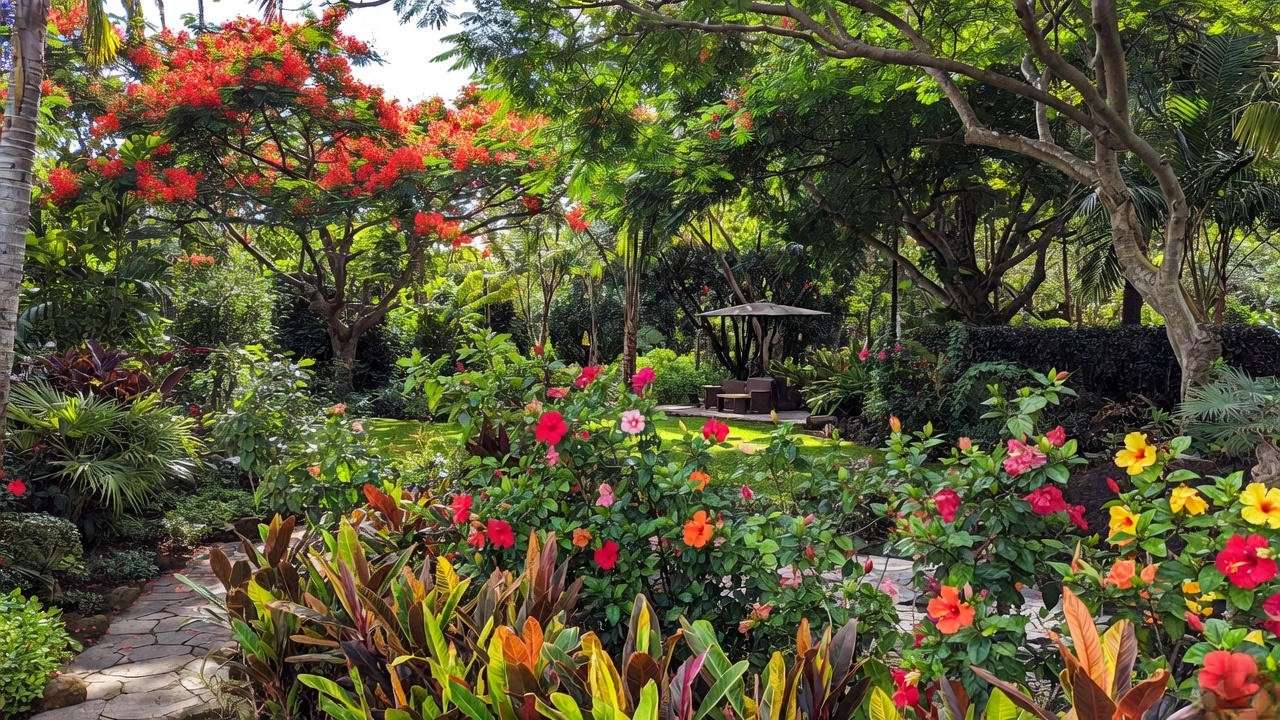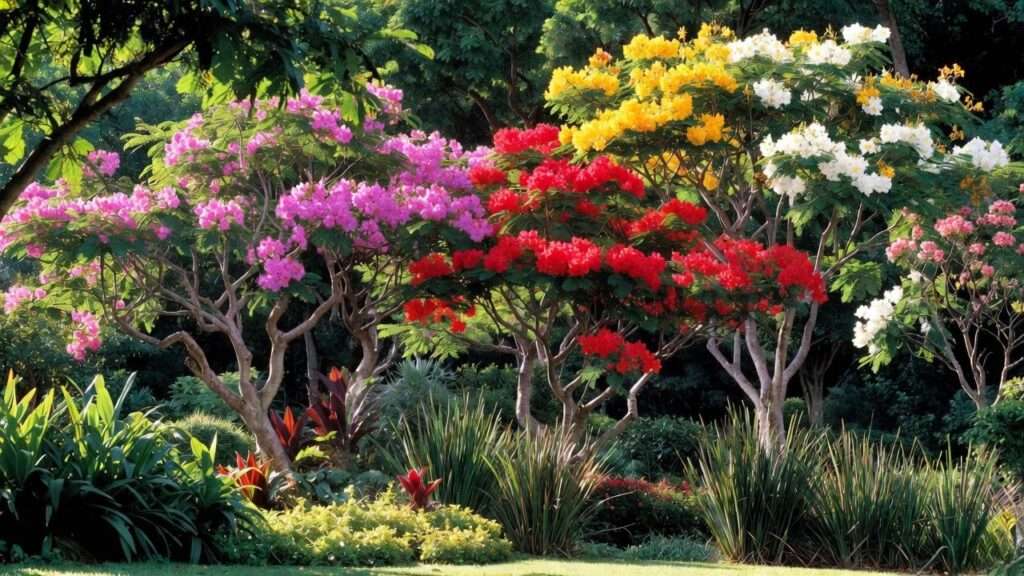Picture this: your backyard bathed in vibrant hues of red, yellow, and purple, with fragrant blossoms swaying in the breeze, transporting you to the lush landscapes of Hawaii. Flowering Hawaiian trees can turn this tropical dream into reality, adding unmatched beauty and aloha spirit to any garden. Whether you’re a seasoned gardener or a beginner eager to cultivate a slice of paradise, these stunning trees offer vibrant blooms, ecological benefits, and cultural significance. In this comprehensive guide, we’ll explore the top 10 flowering Hawaiian trees, share expert care tips, and show you how to create a thriving tropical oasis—no matter where you live. Ready to transform your garden? Let’s dive in! 🌴
Section 1: Why Choose Flowering Hawaiian Trees for Your Garden? 🌸
The Unique Appeal of Hawaiian Trees in Landscaping
Flowering Hawaiian trees are more than just plants—they’re a statement of beauty and tranquility. Their vivid blooms, from the fiery reds of the royal poinciana to the delicate pinks of plumeria, create breathtaking focal points in any landscape. These trees don’t just enhance aesthetics; they evoke the serene, tropical vibe of Hawaii, making your garden feel like a year-round vacation spot. For example, the rainbow shower tree, with its cascading multicolored blossoms, can turn a mundane backyard into a vibrant masterpiece. 🌈
Beyond looks, these trees offer practical benefits. They provide shade, reduce urban heat, and create inviting spaces for relaxation. Their unique shapes—think the sprawling canopy of the jacaranda or the compact elegance of a hibiscus tree—suit various garden styles, from minimalist to lushly tropical.
Ecological Benefits
Flowering Hawaiian trees are ecological superstars. Their nectar-rich blooms attract pollinators like bees, butterflies, and native birds, supporting local biodiversity. For instance, the ʻōhiʻa lehua’s vibrant red flowers are a favorite of Hawaiian honeycreepers, contributing to pollination networks. Many of these trees, especially natives like koa and ʻōhiʻa, are drought-tolerant once established, making them sustainable choices for water-conscious gardeners. 🌿
Expert Insight: Native Hawaiian trees often require less maintenance than exotic species, as they’re adapted to local soils and climates. By choosing them, you’re not only beautifying your space but also promoting environmental health.
Cultural Significance
Hawaiian trees carry deep cultural meaning. The ʻōhiʻa lehua, sacred in Hawaiian mythology, is tied to stories of love and resilience, symbolizing the spirit of the islands. Plumeria, often used in leis, represents positivity and celebration. Incorporating these trees into your garden is a way to honor Hawaiian heritage while creating a meaningful connection to nature. Tip: Research the cultural context of each tree to deepen your appreciation and share its story with visitors. 🌺
Are Flowering Hawaiian Trees Right for Your Climate?
While these trees thrive in Hawaii’s tropical climate (USDA zones 9–11), many adapt to subtropical and even temperate regions with proper care. For example, plumeria and hibiscus can be grown in containers and brought indoors during cold snaps, making them viable for zones 7–8. Below is a quick reference for climate suitability:
| Tree | USDA Zones | Climate Preference |
|---|---|---|
| Plumeria | 9–11 | Tropical, subtropical |
| Rainbow Shower | 10–11 | Warm, humid |
| ʻŌhiʻa Lehua | 9–11 | Tropical, adaptable |
| Royal Poinciana | 10–12 | Hot, dry-tolerant |
| Blue Jade Vine | 10–11 | Humid, shaded |
Reader Tip: In colder climates, create microclimates using windbreaks or grow trees in pots for mobility. Greenhouses or grow lights can extend their growing season. 🌞
Section 2: The Top 10 Flowering Hawaiian Trees for Vibrant Gardens 🌼
Here’s our expertly curated list of the top 10 flowering Hawaiian trees, each chosen for its beauty, versatility, and garden impact. Backed by insights from Hawaiian botanical gardens and personal experience cultivating tropical plants, these trees will elevate your landscape.
1. Plumeria (Frangipani) 🌺
Description: Known for its fragrant, star-shaped blooms in shades of pink, white, yellow, and red, plumeria is a Hawaiian icon. Its compact size (10–20 feet) makes it ideal for small gardens or containers. Care Tips: Plant in well-draining soil with full sun (6+ hours daily). Water moderately, allowing soil to dry between sessions. Prune lightly in spring to encourage bushier growth. Best For: Patios, small yards, or as a potted centerpiece. Fun Fact: Plumeria’s sweet scent is strongest at night, perfect for evening garden strolls. SEO Note: Targets “plumeria tree care” and “fragrant tropical trees.”

2. Rainbow Shower Tree 🌈
Description: A hybrid of the golden and pink shower trees, this stunner boasts multicolored blooms (yellow, pink, orange) that cascade like a tropical waterfall. It grows 20–40 feet tall. Care Tips: Thrives in full sun with well-drained soil. Water deeply but infrequently once established. Watch for aphids and treat with insecticidal soap. Best For: Large yards, streetscapes, or as a shade tree. Expert Tip: Pair with low-growing shrubs like ti plants for a layered, vibrant look.
3. ʻŌhiʻa Lehua 🌿
Description: This native tree’s vivid red pom-pom flowers are a symbol of Hawaiian resilience. Growing 20–50 feet, it’s a cornerstone of native forests. Care Tips: Prefers acidic, well-drained soil and moderate water. Avoid disturbing roots during planting. Protect from fungal diseases with good air circulation. Best For: Native plant gardens or eco-conscious landscapes. Cultural Note: In Hawaiian lore, picking lehua flowers can bring rain, reflecting its sacred status.

4. Royal Poinciana (Flame Tree) 🔥
Description: With fiery red-orange blooms and a wide canopy (up to 40 feet), this tree is a showstopper. Its fern-like leaves add elegance year-round. Care Tips: Needs full sun and tolerates drought once established. Prune after flowering to maintain shape. Avoid planting near structures due to invasive roots. Best For: Spacious lawns or as a dramatic focal point. Reader Tip: Its shade is perfect for outdoor seating areas.
5. Blue Jade Vine 💙
Description: This rare, vine-like tree produces turquoise flower clusters that dazzle in the sunlight. It grows 15–30 feet with support. Care Tips: Provide a trellis or pergola, partial shade, and rich, moist soil. Fertilize monthly during the growing season. Best For: Vertical gardens or shaded patios. SEO Note: Targets “rare Hawaiian plants” and “unique tropical vines.”
6. Hibiscus Tree 🌸
Description: The hibiscus, Hawaii’s state flower, dazzles with large, trumpet-shaped blooms in red, pink, yellow, or white. Growing 8–15 feet, it can be trained as a tree or shrub. Care Tips: Plant in full sun with rich, well-drained soil. Water regularly, keeping soil consistently moist but not waterlogged. Deadhead spent blooms to encourage continuous flowering. Watch for pests like spider mites and treat with neem oil. Best For: Hedges, privacy screens, or container gardens. Fun Fact: Hibiscus flowers last only a day but bloom prolifically with proper care. SEO Note: Targets “hibiscus tree care” and “tropical privacy plants.”
7. Jacaranda 💜
Description: This deciduous tree’s vibrant purple, bell-shaped flowers create a dreamy canopy in spring. Reaching 25–40 feet, it’s a favorite for ornamental landscapes. Care Tips: Prefers full sun and well-drained soil. Water moderately, reducing in winter. Protect young trees from strong winds. Prune to shape after flowering. Best For: Shade trees or street planting. Expert Insight: Its fallen petals create a stunning purple carpet, perfect for Instagram-worthy gardens. SEO Note: Targets “jacaranda tree landscaping” and “purple flowering trees.”
8. African Tulip Tree 🌷
Description: Known for its bold orange-red trumpet flowers, this fast-growing tree reaches 25–50 feet. Its lush foliage adds tropical flair. Care Tips: Thrives in full sun with moist, well-drained soil. Monitor for invasiveness, as it can spread rapidly in warm climates. Prune to control size and remove seed pods. Best For: Large properties or open landscapes. Reader Warning: Check local regulations, as it’s considered invasive in some areas. SEO Note: Targets “African tulip tree care” and “fast-growing tropical trees.”
9. Golden Shower Tree 💛
Description: This moderate-sized tree (20–30 feet) produces cascading clusters of bright yellow blooms, resembling a golden waterfall. Care Tips: Plant in full sun with well-drained soil. Water sparingly once established, as it’s drought-tolerant. Light pruning after blooming maintains shape. Best For: Urban gardens, courtyards, or small lots. Tip: Combine with dark green foliage for a striking color contrast. SEO Note: Targets “golden shower tree landscaping” and “yellow flowering trees.”
10. Koa Tree (with Flowering Varieties) 🌳
Description: A revered Hawaiian native, koa produces subtle yellow puffball blooms and is prized for its rich hardwood. It grows 30–80 feet, depending on conditions. Care Tips: Requires deep, infrequent watering and well-drained soil. Protect from pests like koa beetles with organic insecticides. Avoid heavy pruning to preserve its natural form. Best For: Native restoration projects or large landscapes. Cultural Note: Koa is used in traditional Hawaiian canoes, symbolizing strength and heritage. SEO Note: Targets “koa tree care” and “native Hawaiian trees.”
Section 3: How to Care for Flowering Hawaiian Trees Like a Pro 🌱
Essential Care Tips for Thriving Tropical Trees
Proper care ensures your flowering Hawaiian trees flourish, rewarding you with vibrant blooms and healthy growth. Here’s a breakdown of key care practices, informed by years of tropical gardening experience and recommendations from the University of Hawaii’s botanical resources.
Soil and Fertilization
Most Hawaiian trees thrive in well-draining, slightly acidic soil (pH 5.5–6.5). A mix of sandy loam, compost, and perlite works well for drainage and nutrient retention. Fertilize with a balanced, slow-release formula (e.g., 10-10-10) every 2–3 months during the growing season (spring–summer). For bloom-heavy trees like plumeria and hibiscus, use a fertilizer high in potassium to enhance flower production. Example: Apply a palm-specific fertilizer to royal poinciana for robust growth. Tip: Test soil pH annually to ensure optimal conditions.
Watering and Drainage
Watering needs vary by tree, but overwatering is a common mistake. Most trees, like the golden shower and royal poinciana, are drought-tolerant once established, requiring deep, infrequent watering (every 7–10 days). Others, like the blue jade vine, prefer consistently moist soil. Ensure excellent drainage to prevent root rot, especially in heavy clay soils. Reader Tip: Mulch with organic materials like bark or coconut husk to retain moisture and regulate soil temperature. Expert Insight: Install a drip irrigation system for efficient, targeted watering in tropical gardens.

Pruning and Maintenance
Pruning enhances shape, promotes blooms, and removes dead or diseased branches. For most trees, prune lightly after flowering to avoid cutting next season’s buds. For example, trim plumeria in early spring to encourage bushier growth, and shape jacaranda post-bloom to maintain its canopy. Use clean, sharp tools to prevent disease spread. Step-by-Step Pruning Guide:
- Sterilize pruning shears with rubbing alcohol.
- Remove dead or crossing branches.
- Cut at a 45-degree angle just above a node.
- Step back to assess shape and balance. Expert Tip: Timing pruning to post-bloom cycles maximizes flower production.
Pest and Disease Management
Common pests include aphids (rainbow shower), scale insects (hibiscus), and koa beetles (koa). Inspect leaves regularly for signs of damage, such as yellowing or sticky residue. Organic solutions like neem oil or insecticidal soap are effective and eco-friendly. Fungal issues, like root rot or leaf spot, often stem from poor drainage or overcrowding. Ensure good air circulation and avoid overhead watering. Reader Tip: Introduce beneficial insects, like ladybugs, to naturally control aphid populations. SEO Note: Targets “tropical tree pest control” and “organic gardening solutions.”
Adapting Care to Your Environment
Not in a tropical climate? You can still grow these trees with adjustments. Container gardening is ideal for plumeria, hibiscus, and blue jade vine, allowing you to move them indoors during winter (zones 7–8). Use grow lights to mimic sunlight for indoor trees. In temperate regions, create microclimates with windbreaks or south-facing walls to trap heat. For example, I’ve successfully grown plumeria in a zone 8 garden by overwintering it in a heated garage. SEO Note: Targets “grow Hawaiian trees in cold climates” and “container gardening tropical plants.” Example: A 20-gallon pot with casters makes hibiscus mobile and easy to protect from frost.
Section 4: Designing Your Garden with Flowering Hawaiian Trees 🏡
Creating a Tropical Paradise at Home
A well-designed garden maximizes the beauty of flowering Hawaiian trees while ensuring their health. Here’s how to integrate these trees into a stunning, functional landscape.
Layout and Placement Ideas
Consider each tree’s mature size and sunlight needs when planning your layout. Use tall trees like royal poinciana or koa as focal points in large yards, and place compact trees like plumeria near patios for fragrance. Create layers by pairing trees with low-growing companions, such as ti plants or bird of paradise, for texture and color. Example: A rainbow shower tree as a centerpiece, surrounded by hibiscus shrubs and groundcover like mondo grass, creates a vibrant, tropical vignette. Tip: Space trees 10–20 feet apart to avoid crowding and ensure air circulation.
Container Gardening for Small Spaces
For urban gardeners or small spaces, plumeria, hibiscus, and blue jade vine thrive in containers. Choose large, decorative pots (15–20 gallons) with drainage holes. Place them on patios, balconies, or courtyards for a tropical touch. Reader Tip: Use pot risers to improve drainage and prevent root rot. SEO Note: Targets “container gardening Hawaiian trees” and “small space tropical plants.”

Sustainable Landscaping Practices
Incorporate eco-friendly practices to make your garden sustainable. Use drip irrigation to conserve water, especially for drought-tolerant trees like golden shower. Mulch with organic materials to suppress weeds and retain moisture. Integrate native plants, like ʻōhiʻa lehua, to support local ecosystems. Expert Insight: Rain barrels can collect runoff to water your trees, reducing your environmental footprint. SEO Note: Targets “sustainable tropical gardening” and “eco-friendly landscaping.”
Section 5: Common Mistakes to Avoid When Growing Flowering Hawaiian Trees 🚫
Even experienced gardeners can make mistakes with tropical trees. Here are pitfalls to avoid, based on common issues observed in Hawaiian and tropical gardens:
- Overwatering: Leads to root rot, especially in poorly drained soils. Check soil moisture before watering.
- Poor Site Selection: Planting in shade or windy areas stunts growth. Ensure 6+ hours of sun and wind protection.
- Neglecting Pests: Ignoring early signs of pests (e.g., sticky leaves) can lead to infestations. Inspect weekly.
- Improper Pruning: Cutting at the wrong time reduces blooms. Prune post-flowering for best results. Reader Tip: Keep a gardening journal to track watering, fertilizing, and pest checks for each tree. SEO Note: Targets “common mistakes growing tropical trees” and “Hawaiian tree care tips.”
Section 6: FAQs About Flowering Hawaiian Trees ❓
Your Questions Answered
To address common reader queries and boost SEO for voice search, here are answers to frequently asked questions about flowering Hawaiian trees, based on insights from tropical gardening communities and botanical resources.
Q1: Which flowering Hawaiian tree is easiest for beginners? A: Plumeria is the top choice for beginners. Its low maintenance, tolerance for various soils, and ability to thrive in containers make it forgiving for novice gardeners. With full sun and occasional watering, you’ll enjoy fragrant blooms in no time. 🌺 SEO Note: Targets “best Hawaiian trees for beginners.”
Q2: Can I grow these trees in colder climates? A: Yes, with adjustments! Plumeria, hibiscus, and blue jade vine adapt well to container gardening, allowing you to bring them indoors during winter in zones 7–8. Use grow lights and maintain temperatures above 50°F. For outdoor planting in cooler regions, choose hardy varieties like jacaranda and create microclimates with windbreaks. 🌞 SEO Note: Targets “grow Hawaiian trees in cold climates.”
Q3: How often should I fertilize my Hawaiian trees? A: Fertilize every 2–3 months during the growing season (spring–summer) with a balanced, slow-release fertilizer (e.g., 10-10-10). For bloom-heavy trees like hibiscus or plumeria, use a potassium-rich formula monthly to boost flowers. Avoid fertilizing in winter when growth slows. 🌱 SEO Note: Targets “fertilizing tropical trees.”
Q4: Are any of these trees invasive? A: The African tulip tree can be invasive in warm, humid climates due to its rapid seed dispersal. Check local regulations before planting, and remove seed pods to control spread. Other trees, like plumeria and ʻōhiʻa lehua, are non-invasive and safe for most gardens. 🌷 SEO Note: Targets “invasive Hawaiian trees.”
Q5: What’s the best time to plant flowering Hawaiian trees? A: Spring or early summer is ideal, as warm temperatures and longer daylight hours promote root establishment. In tropical climates, planting during the rainy season ensures adequate moisture. For container trees, you can plant year-round indoors with proper care. 🌳 SEO Note: Targets “when to plant tropical trees.”

Section 7: Conclusion: Transform Your Garden with Flowering Hawaiian Trees 🌴
Flowering Hawaiian trees are more than just plants—they’re a gateway to creating a vibrant, tropical paradise in your own backyard. From the fragrant plumeria to the fiery royal poinciana, these top 10 trees offer stunning blooms, ecological benefits, and a touch of aloha spirit. By following our expert care tips—choosing the right soil, watering wisely, and pruning strategically—you can ensure your trees thrive, whether you’re in a tropical haven or a temperate zone. Avoid common pitfalls like overwatering or poor site selection to keep your garden flourishing.
Ready to start your tropical journey? Pick a tree that suits your space and climate—plumeria for beginners, rainbow shower for bold color, or ʻōhiʻa lehua for cultural significance—and plant it this season. Imagine sipping coffee under the shade of a golden shower tree or hosting friends amidst hibiscus blooms. Your dream garden is within reach! 🌺













